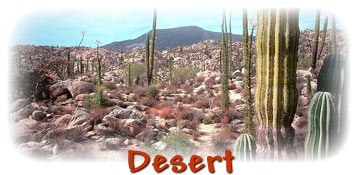| Hot Deserts of the
World
The
main form of precipitation in a hot desert is rain. But that's only ten
inches or less of rain per year.
| Hot
Deserts of the World |
Name
Location |
Size |
Physical
Features |
Some Plants
& Animals |
Special
Facts |
Arabian
Arabian Peninsula |
900,000 mi2
2,300,000 km2 |
Covered almost entirely by sand; has some
of the most extensive stretches of sand dunes in the world. |
acacia, oleander, saltbush
desert locust, dromedary camel, gazelle, lizard, jackal,
oryx |
Nomadic Bedouin tribes have travelled through
the Arabian Desert for thousands of years. |
Australian (Great Sandy, Victoria,
Simpson, Gibson, and Sturt)
Australia |
890,00 mi2
2,300,000 km2
(1/3 of Australia) |
Great Sandy, Victoria, and Simpson are sandy;
Gibson and Sturt are stony. |
acacia, casuarina tree, eucalyptus, saltbush,
spinifex grass
blue-tongued lizard, dingo, fat-tailed mouse, kangaroo,
marsupial mole, rabbit-eared bandicoot, sand goanna, spinifex hopping mouse,
throny devil |
Aborigines have lived in the Australian deserts
for over 30,000 years. |
Chihuahuan
North Central Mexico and Southwestern United States
(Arizona, New Mexico, Texas) |
175,000 mi2
455,000 km2 |
High plateau covered by stony areas and sandy
soil. Many mountains and mesas. |
cacti, chihuahuan flax, creosote bush, lechuguilla,
mesquite, mexican gold poppy
coyote, diamondback rattlesnake, javelina, kangaroo rat,
roadrunner |
Largest North American desert. Big Bend National
Park located here; more species of birds seen in Big Bend than in any other
National Park in the U.S. |
Kalahari
Southwestern Africa |
200,000 mi2
520,000 km2 |
Covered by sand dunes and gravel plains. |
acacia, aloe
gazelle, gerbil, ground squirrel, hyena, jackel, sandgrouse,
springbok |
Bushman have lived in the Kalahari for 20,000
years. |
Mojave
Southwestern United States (Arizona, California, Nevada) |
25,000 mi2
65,000 km2 |
Covered by sandy soil, gravelly pavement,
and salt flats. |
creosote bush, desert sand verbena, joshua
tree, mesquite
bighorn sheep, chuckwalla, coyote, jackrabbit, sidewinder,
zebra-tailed lizard |
Death Valley located in this desert. |
Monte
Argentina |
125,000 mi2
325,000 km2 |
Covered by sand and soil |
cardon cactus, creosote bush, paloverde
armadillo, cavy, jaguarundi, puma, tinamou, tuco-tuco |
Very similar to the Sonoran Desert |
Sahara
Northern Africa |
3,500,000 mi2
9,100,000 km2 |
Covered by mountains, rocky areas, gravel
plains, salt flats, huge areas of dunes. Areas in the central sometimes
get no rain for years at a time. |
acacia, grasses, tamarisks
addax antelope, dorcas gazelle, fennec fox, horned viper,
jackal, jerboa, sandgrouse, spiny-yailed lizard |
Largest desert in the world. Fewer than 2
million inhabitants (mostly nomads such as the Tuareg). Crossed by Arab
caravans since the 10th century. |
Sonoran
Southwestern United States (Arizona, California) and
parts of Mexico (Baja Peninsula, Sonora) |
120,000 mi2
312,000 km2 |
Covered by sand, soil, and gravelly pavement.
Gets more rain than any other North American desert. |
agave, coulter's globemallow, creosote bush,
desert mariposa lily, mesquite, ocotillo, paloverde, saguaro
coati, elf owl, gila monster, kangaroo rat, pack rat,
roadrunner, sidewinder, tarantula |
Most complex animal-plant community of any
desert.
One of the most beautiful deserts in the world. |
Thar
India and Pakistan |
77,000 mi2
200,000 km2 |
Majority of desert covered by sand dunes;
rest covered by gravel plains |
acacia, euphorbias, grasses, shrubs
black buck, dromedary camel, great Indian bustard, Indian
spiny-tailed lizard, jackel, sandgrouse |
Small villages of ten to twenty houses scattered
throughout the Thar. |
| Disclaimer |
Copyright © 2002 Missouri
Botanical Garden
|
 |
|
